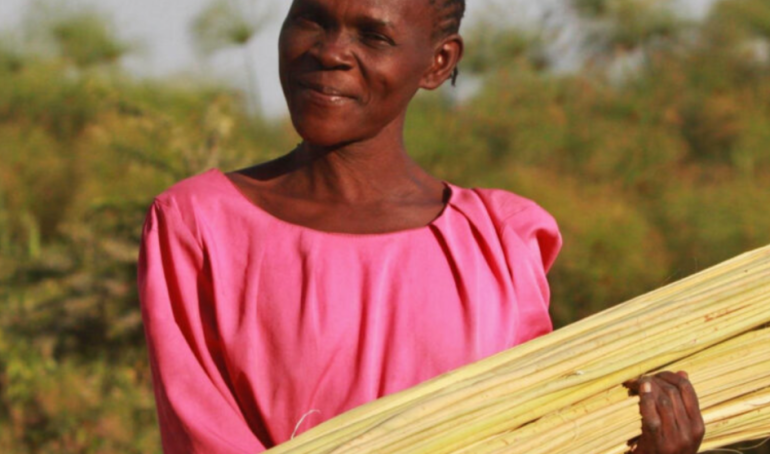Omanyano ovanhu koikundaneki yomalungula kashili paveta, Commisiner Sakaria takunghilile
Veronika Haulenga
Omanyano ovanhu koikundaneki yomalungula kashili paveta, Commisiner Sakaria takunghilile
Veronika Haulenga
Listeners:
Top listeners:
-
play_arrow
Omanyano ovanhu koikundaneki yomalungula kashili paveta, Commisiner Sakaria takunghilile Veronika Haulenga
Livelihoods at stake as Lake Victoria’s papyrus swamps come under pressure


Sarah Oginga harvesting papyrus reeds. Image by Patrick B. Newcombe.
By Patrick Newcombe via Mongabay
As the sun rises over the wetlands on the shores of Lake Victoria, papyrus harvesters set out into the swamps to harvest stalks of papyrus. At the docks, fishermen returning from a night’s work haul their boats onto the shore. The deep, ringing song of the papyrus gonolek (Laniarius mufumbiri) and the hooting of the blue-headed coucal (Centropus monachus) drift out from the reeds.
 Papyrus swamps at dawn, near Kisumu, Kenya. Victoria. Image by Patrick B. Newcombe.
Papyrus swamps at dawn, near Kisumu, Kenya. Victoria. Image by Patrick B. Newcombe.
The calls of birds and men, and the fish and reeds piled high, appear to be signs of a flourishing ecosystem. These papyrus swamps, which form on the edges of Lake Victoria and other lakes and rivers in the region, are a haven for range-restricted birds and cichlid fish populations that have survived the introduction of commercially-valuable fish like Nile perch (Lates niloticus).
A range of factors, including potential overharvesting of papyrus (Cyperus papyrus) and the conversion of the swamps for agriculture and construction, threaten this remarkable ecosystem. Many coastal residents who rely on the swamps for their livelihoods have begun to voice concerns about the ecosystem’s future.
 Dickson Omondiwao weaves dried papyrus reeds into a mat that will be sold in the nearby city of Kisumu. He says that this work – which he has been doing since 1985 – has enabled him to pay school fees for his four children. Image by Patrick B. Newcombe.
Dickson Omondiwao weaves dried papyrus reeds into a mat that will be sold in the nearby city of Kisumu. He says that this work – which he has been doing since 1985 – has enabled him to pay school fees for his four children. Image by Patrick B. Newcombe.
An ecosystem that supports livelihoods
Dickson Omondiwao has worked in the papyrus swamps of Kenya’s Kisumu county since 1985. Each morning he ventures into the swamps to harvest a large bundle of papyrus. In the afternoons, he starts weaving and typically makes three mats per day, each of which takes 200 stalks, he estimates. A middleman buys them from him to sell at a market in Kisumu, he says. The mats are used for many things, often in wall construction.
 Bundles of papyrus drying, so that they can be woven into other products. Image by Patrick B. Newcombe.
Bundles of papyrus drying, so that they can be woven into other products. Image by Patrick B. Newcombe.
Fredrick Odhiambo, who weaves mats and other handicrafts from papyrus, says he and other harvesters only cut mature stalks, allowing young ones to grow up in their place and helping the swamp regenerate.
 Fish traps line the channels through a papyrus swamp. Image by Patrick B. Newcombe.
Fish traps line the channels through a papyrus swamp. Image by Patrick B. Newcombe.
In the shallow channels that wind through the swamps, some fishers use papyrus stalks to build fish traps. In the open water just beyond the swamps, others cast nets into the lake. They fish for silver cyprinid (Rastrineobola argentea), catfish, tilapia and Nile perch — a harvest that includes introduced species that have thrived in the lake.
During the heat of the day, sand harvesters emerge from the papyrus swamps into the open lake. They climb into the water, often chest- or neck-deep, and fill their boats with sand. Then, using a wooden pole, they push their boats back along the channels.
 A sand harvester pushes his boat, laden low, through the papyrus swamps. Image by Patrick B. Newcombe.
A sand harvester pushes his boat, laden low, through the papyrus swamps. Image by Patrick B. Newcombe.
 On shore, men shovel the sand into the bed of a truck, which will haul it away. Image by Patrick B. Newcombe.
On shore, men shovel the sand into the bed of a truck, which will haul it away. Image by Patrick B. Newcombe.
Riding low, laden with hundreds of kilograms of sand, the boats are unloaded at a site where the owners await. Trucks from Kisumu pull up along the rutted dirt road, and more workers shovel the sand into the truck beds, so it can be hauled away for construction in the city. According to one boat owner, “This is our gold, that God has given us.”
 Emmanuelle Frederick Makokha casts his net at sunset. He says he moved to Kisumu in search of better fishing, after fish stocks near his hometown became too low. Image by Patrick B. Newcombe.
Emmanuelle Frederick Makokha casts his net at sunset. He says he moved to Kisumu in search of better fishing, after fish stocks near his hometown became too low. Image by Patrick B. Newcombe.
 Another fisher hauls in his net at night, hoping for a strong catch. Image by Patrick B. Newcombe.
Another fisher hauls in his net at night, hoping for a strong catch. Image by Patrick B. Newcombe.
At dusk, Emmanuelle Frederick Makokha swings his net through the air several times before casting it outward, so that weights on the end of the net sink down, pulling fish into the net; his cousin pilots the wooden boat. They say they fish in the evenings, often past dark.
As night falls, other fishermen eat their evening meals on the shore, before climbing into their boats, three or four people per vessel. Many will spend the whole night on the lake, laying out nets held afloat by strings of buoys that stretch hundreds of meters.
At dawn, they bring their boats to shore next to the papyrus swamps at Dunga Beach, where restaurant owners, merchants and others looking to buy fresh fish meet them.
 Much of the fish landed in Kisumu is Nile perch (Lates niloticus). According to research by Robert Pringle, this fish was first introduced in the 1950s, in secrecy, reportedly at the behest of some in the Uganda Game and Fisheries Department – even as scientists opposed its introduction. Image by Patrick B. Newcombe.
Much of the fish landed in Kisumu is Nile perch (Lates niloticus). According to research by Robert Pringle, this fish was first introduced in the 1950s, in secrecy, reportedly at the behest of some in the Uganda Game and Fisheries Department – even as scientists opposed its introduction. Image by Patrick B. Newcombe.
 In his book, Africa and Encyclopedia of Biological Invasions. Pringle says that since then, Lake Victoria’s fishing economy has become more commercial, favoring those who can afford more expensive fishing gear, and afford to buy relatively expensive Nile perch.. Image by Patrick B. Newcombe.
In his book, Africa and Encyclopedia of Biological Invasions. Pringle says that since then, Lake Victoria’s fishing economy has become more commercial, favoring those who can afford more expensive fishing gear, and afford to buy relatively expensive Nile perch.. Image by Patrick B. Newcombe.
 The fishing industry also supports boat builders, some of whom travel around the region, spending a few days in each town to build boats there. Image by Patrick B. Newcombe.
The fishing industry also supports boat builders, some of whom travel around the region, spending a few days in each town to build boats there. Image by Patrick B. Newcombe.
A refuge for biodiversity
Lake Victoria once held hundreds of haplochromine cichlid species, a spectacular evolutionary radiation that collapsed rapidly following the introduction of Nile perch, which preys on and outcompetes the much smaller cichlids. Closer inshore, the papyrus swamps appear to provide refugia for some remaining native cichlids.
Research by Lauren Chapman, including work published in Biological Conservation and a physiology journal, has suggested that cichlids are better adapted to the swamps’ low-oxygen conditions, which, combined with the dense underwater vegetation, likely make the papyrus swamps a shelter from predation by Nile perch. The swamps are widely believed to provide breeding grounds for other fish, too, and many local fishers credit their role in supporting Lake Victoria’s fisheries.
Inside the papyrus reedbeds live a host of bird species, flourishing in a narrow geographic range and specific habitat of Africa’s Great Lakes.
 A Papyrus Gonolek, a papyrus specialist bird, peers out from deep in the reeds. The species depends on healthy papyrus ecosystems. Image by Patrick B. Newcombe.
A Papyrus Gonolek, a papyrus specialist bird, peers out from deep in the reeds. The species depends on healthy papyrus ecosystems. Image by Patrick B. Newcombe.
One of the most striking birds here, the papyrus gonolek, occurs deep in the reeds, occasionally venturing out to the edges. BirdLife International describes the gonolek as “confined to papyrus Cyperus papyrus swamps and beds, in meandering river valleys and along lake-shores.” The BirdLife assessment suggests the brightly colored species is in “moderately rapid population decline owing to the on-going conversion and degradation of its wetland habitats.”
Papyrus swamps also offer habitat for the vulnerable papyrus yellow warbler (Calamonastides gracilirostris), which can be found in Dunga Swamp, a major papyrus swamp near Kisumu. BirdLife International includes natural resource use as a cause of deterioration of the Dunga Swamp Important Bird Area.
As well as providing habitat for fish and bird life, papyrus swamps rapidly take up nutrients and retain sediment, reducing their flow into lakes. Research published in the journal Wetlands Ecology & Management shows that in the right conditions, C. papyrus allows the development of significant detritus and peat deposits — storing carbon. Conversion to agriculture or development risks undermining these ecosystem services as well as biodiversity loss.
But research published in Biological Conservation has suggested that “low-intensity use of papyrus wetlands by people is compatible with the conservation of specialist bird species,” especially when large areas of papyrus are protected. It adds that “conservation in tropical wetlands need not require complete exclusion of human resource use.” Kenyan environmental scientist Leonard Akwany, a founder and member of the advisory board at Ecofinder Kenya, says papyrus harvesting should be “organized and planned.”
 A kingfisher perches atop a papyrus stalk. Image by Patrick B. Newcombe.
A kingfisher perches atop a papyrus stalk. Image by Patrick B. Newcombe.
Drivers of degradation and loss
On the lush areas behind the papyrus swamps, farmers tend to their rice fields. Often, this is former swampland that’s been drained, according to Akwany.
He says some people set the papyrus on fire to open up new areas for fishing or sand harvesting. Nicholas Oginga Toya, who lives next to a papyrus swamp, also worries about this burning, which prevents him and his family from harvesting papyrus reeds. Burning could also be a precursor to longer-term agricultural conversion.
 Rice being cultivated not far from Dunga Swamp in Kisumu County, Kenya. Image by Patrick B. Newcombe.
Rice being cultivated not far from Dunga Swamp in Kisumu County, Kenya. Image by Patrick B. Newcombe.
The threats of conversion can be severe. Between 1990 and 2017, the Ombeyi Wetland, which covered about 1,000 hectares (2,500 acres) of papyrus, also in Kisumu county, was almost entirely converted to agriculture and new settlements, based on research by Nicodemus Osoro Odhiambo.
Behind the largest lakeshore papyrus swamp near Kisumu, new residential areas have been constructed in the last few years. Farmers tend vegetables and pastoralists herd small groups of cattle. The soil of the new elevated roads is still fresh. But nearby residents say they’re on swampland and that the new homes flood every year.
 Soil fresh from being hauled in, with remaining papyrus swamp in the background. Image by Patrick B. Newcombe.
Soil fresh from being hauled in, with remaining papyrus swamp in the background. Image by Patrick B. Newcombe.
Akwany cites several resorts and restaurants in the county capital, Kisumu, that were newly developed on top of papyrus swamps. Many have hauled in rocks and soil to elevate them above the swamp. He says these resorts, as well as agricultural conversion, are eliminating papyrus habitat. By contrast, he says, papyrus that’s intermittently harvested generates more value for biodiversity.
Oginga Toya agrees that the papyrus swamps also have a less tangible, non-economic value. He calls them a “holy thing,” adding that, sometimes, “I go and sit in a quiet place right inside [the papyrus swamp].” He refers to spirits that live in the swamps. A number of residents suggest that they hold religious significance and are the site of spiritual practices.
 Oginga Toya and his family display some of the products they have made from papyrus, with uncut reeds looming in the background. Image by Patrick B. Newcombe.
Oginga Toya and his family display some of the products they have made from papyrus, with uncut reeds looming in the background. Image by Patrick B. Newcombe.
Concerned about the effect construction may have on accessing the papyrus, Oginga Toya says he hopes the government limits how close to the swamp anyone builds. Whatever the solution, many residents feel strongly that important aspects of their livelihoods and lifestyles depend on the health of the swamp.
To read the original article click here.
Citations:
Pringle, R. M. (2005). The origins of the Nile perch in Lake Victoria. BioScience, 55(9), 780-787. doi:10.1641/0006-3568(2005)055[0780:tootnp]2.0.co;2
Pringle, R. M. (2005). The Nile perch in Lake Victoria: Local responses and adaptations. Africa, 75(4), 510-538. doi:10.3366/afr.2005.75.4.510
van Dam, A. A., & Kipkemboi, J. (2018). Sustainable use of papyrus from Lake Victoria, Kenya. In Finlayson, C. M., et al. (Eds.) The Wetland Book (pp. 1113-1124). Springer, Dordrecht. doi:10.1007/978-90-481-9659-3_207
Donaldson, L., Woodhead, A. J., Wilson, R. J., & Maclean, I. M. (2016). Subsistence use of papyrus is compatible with wetland bird conservation. Biological Conservation, 201, 414-422. doi:10.1016/j.biocon.2016.07.036
Written by: Contributed
Africa Conservation Lake Victoria Papyrus Papyrus swamps
Similar posts
Windhoek Weather
Most popular

Namdia Heist: More questions, lots of confusion

Omuhwahwameki Michael okuunganeka oshikonga shoku patitha oostola dho Rani moshilongo ashihe.

Walvis Bay woman loses over N$777.000 to a fraudster

Don’t let Pohamba’s tears over Nujoma’s death go to waste

Justice Served: Jandre Dippenaar Found Guilty of Six Murders in Swakopmund Court
Copyright 2025 Future Media (Pty) Ltd | Website by Digital Platforms
Tel: +264 83 000 1000 | Email: news@futuremedia.com.na





